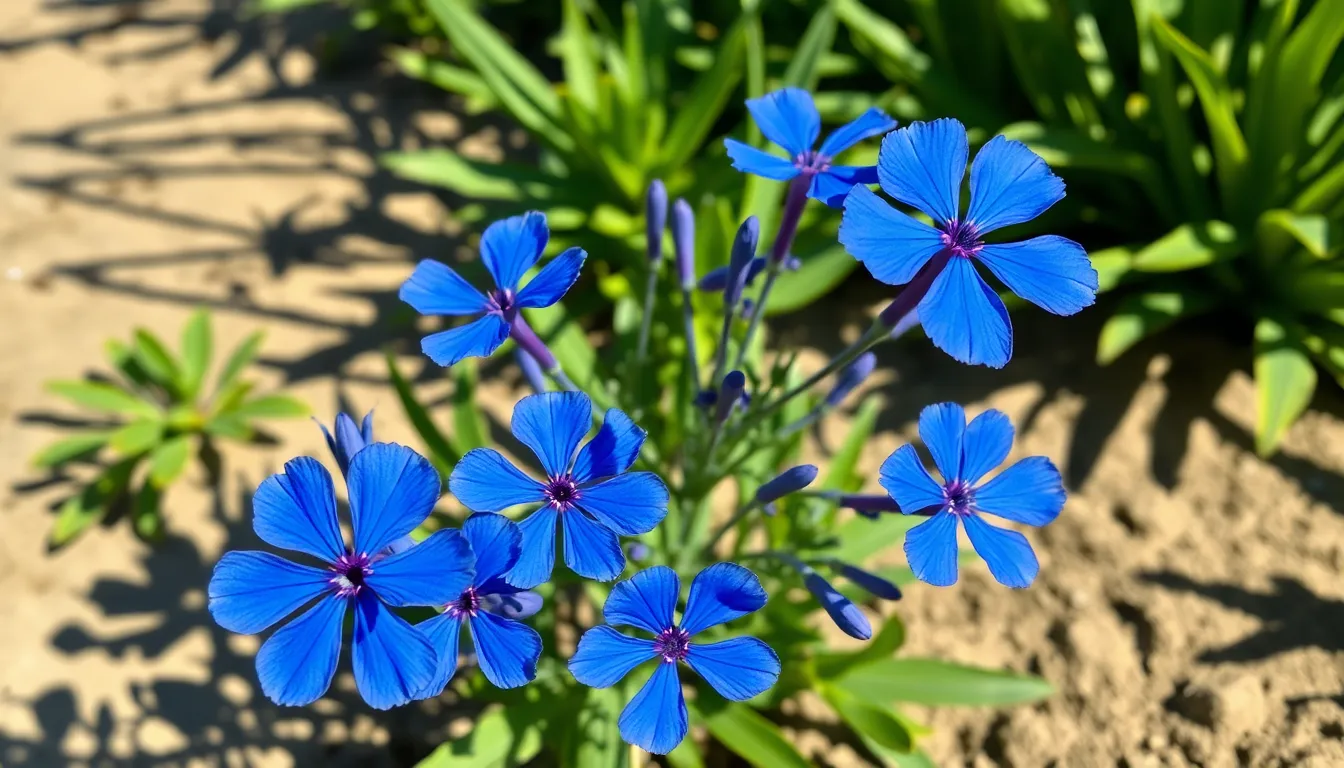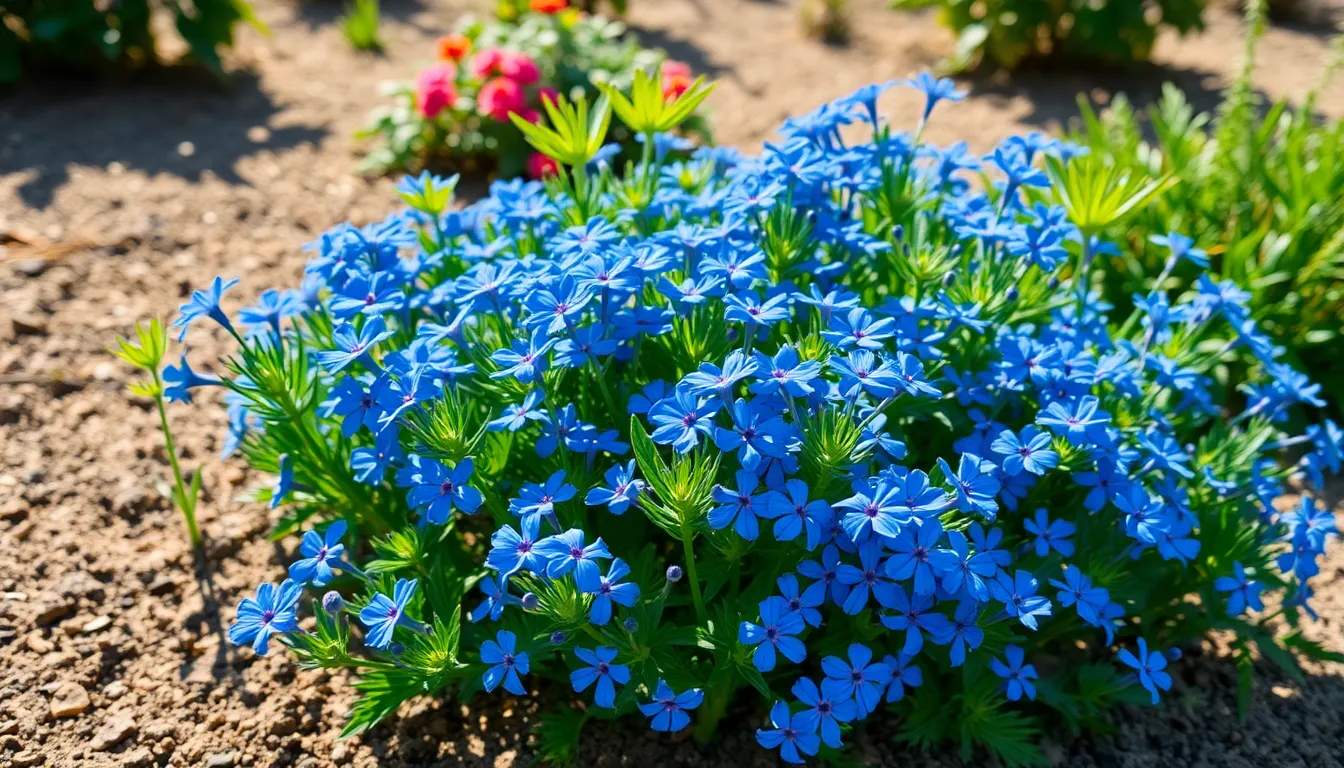If you’re looking to add a splash of vibrant blue to your garden, the blue daze plant is your go-to choice. This stunning ground cover not only dazzles with its brilliant blooms but also thrives on neglect—perfect for those who might forget to water their plants (no judgment here).
Blue Daze Plant
Blue daze, known scientifically as Evolvulus glomeratus, features striking blue flowers that enhance any outdoor space. This perennial plant thrives in warm climates, often reaching heights of about 12 to 18 inches and spreading up to 24 inches wide. Blooms appear from spring through fall, attracting pollinators like bees and butterflies.
This plant prefers full sun, making it an excellent choice for sunny gardens. A well-draining soil mix promotes optimal growth, allowing the roots to flourish without rot. Regular watering, particularly during dry periods, supports its health, although blue daze tolerates occasional drought.
Fertilizing blue daze isn’t necessary but can enhance blooming. A balanced, slow-release fertilizer applied in early spring boosts flower production. Choosing to deadhead spent blooms extends the flowering season, keeping the plant looking fresh.
Pests and diseases rarely affect this resilient plant. Occasional aphids or spider mites may appear, yet they typically do not threaten overall growth. Monitoring the plant and addressing issues promptly ensures ongoing vitality.
Incorporating blue daze into garden designs lends a cheerful touch. Its low-maintenance appeal makes it perfect for busy gardeners or those looking for easy solutions. Furthermore, versatility in landscaping allows for use in borders, containers, or as ground cover without issue.
Ideal Growing Conditions

Blue daze thrives under specific conditions that enhance its vibrant blooms and overall health. Creating an optimal environment promotes growth and flowering throughout its blooming season.
Sunlight Requirements
Bright sunlight plays a crucial role in the health of blue daze. This plant flourishes in full sun, requiring at least six hours of direct sunlight daily. When positioned in a sunny spot, it produces abundant blooms that showcase its striking blue color. Limited sunlight results in leggy growth and fewer flowers, diminishing its aesthetic appeal.
Soil Preferences
Well-draining soil is essential for blue daze to thrive. It prefers sandy or loamy soils with good drainage capabilities. High moisture retention can lead to root rot, which negatively impacts plant health. Amending soil with organic matter can improve drainage and provide necessary nutrients. Testing soil pH for a neutral to slightly acidic level aids in creating an ideal growing environment.
Watering Guidelines
Blue daze requires careful attention to watering for optimal health. Understanding frequency and amount fosters vibrant growth.
Frequency and Amount
Watering blue daze plants should occur once or twice a week, depending on weather conditions. During hot, dry spells, increasing watering frequency helps maintain soil moisture. Ensuring the soil dries out slightly between waterings prevents excess moisture. A deep soak is beneficial, reaching about 6 to 8 inches below the surface, encouraging strong root development. Using well-draining soil also aids in moisture management, allowing for even distribution of water. Adjustments to the schedule may be needed as seasons change, promoting the plant’s growth cycles.
Signs of Overwatering
Detecting overwatering in blue daze involves monitoring several key indicators. Yellowing leaves signal excess moisture in the soil, while wilting can occur despite wet conditions. Root rot appears as mushy roots, often leading to plant decline. An unpleasant smell from the soil may indicate decaying roots. Adjusting the watering schedule plays a crucial role in preventing these issues. If any of these signs manifest, reducing watering frequency allows the plant time to recover and thrive once more.
Fertilization Tips
Fertilizing blue daze can enhance blooming without being mandatory. Using the right type of fertilizer supports vibrant flowers and overall plant health.
Best Types of Fertilizers
Slow-release, balanced fertilizers work well for blue daze. Select options with an N-P-K ratio of 10-10-10 or similar, which gives essential nutrients for growth. Organic fertilizers, such as compost or fish emulsion, also benefit the plant while improving soil structure. Liquid fertilizers can provide a quick nutrient boost during the growing season. Always choose a formula lower in nitrogen to avoid excessive foliage at the cost of blooms.
When to Fertilize
Apply fertilizers in early spring as new growth begins. A second application may occur mid-summer to promote continued blooming. Monitor the plant’s growth and adjust timing based on growth patterns. If blooms start to diminish, an additional dose of fertilizer can revitalize the plant’s flowers. Over-fertilization may harm the plant; always follow instructions carefully to prevent nutrient buildup.
Common Pests and Diseases
Blue daze plants face minimal pest and disease threats, but occasional issues can arise. Identifying these problems early helps maintain plant health.
Prevention Strategies
Regularly inspecting blue daze can prevent infestations. The plant benefits from healthy growth in well-draining soil, which minimizes stress and susceptibility to pests. Keeping weeds and debris removed around the planting area reduces hiding spots for pests. Encouraging natural predators, such as ladybugs, supports pest control. Chemical pesticides should be avoided as they can disrupt the plant’s growth and the surrounding ecosystem.
Treatment Options
If aphids or spider mites appear, treating the plant with insecticidal soap or neem oil effectively manages these pests. Spraying the affected areas thoroughly ensures coverage and penetration. For minor infestations, washing the leaves with a gentle stream of water can dislodge pests. Maintaining proper watering and fertilization schedules promotes the plant’s resilience, aiding recovery from any pest damage. Surveillance after treatment helps to confirm pest removal.
Conclusion
Caring for the blue daze plant can bring vibrant color and charm to any garden. Its low-maintenance nature makes it an excellent choice for busy individuals or those new to gardening. By ensuring it receives ample sunlight and well-draining soil, gardeners can enjoy its stunning blooms from spring through fall.
Regular monitoring of watering and occasional fertilization can further enhance its beauty. With minimal pest concerns and the ability to thrive in warm climates, blue daze stands out as a resilient and versatile addition to any landscape. Embracing this plant can lead to a flourishing outdoor space that requires little effort while delivering maximum visual impact.





